|
|
|
When I first started this project, I had hoped to be able to link pewter usage to the political and economic pressures of the time. I thought that when times were good and tin could be easily obtained that the amount of pewter used on each stein would be at a maximum, and the amount of pewter would be minimal when times were bad. This only seems to be the case after the Franco-Prussian War. Before that, it would appear, the opposite was true.
Prior to the late seventeenth century, tin, the major ingredient in pewter, was mined in only three European countries, England, Saxony and Bohemia; but production had dropped off in Saxony and Bohemia after the 30 Years War (1618-1648), and the deposits were pretty much played out by the time the Dutch started to import tin from Siam (Thailand) in 1680. So, after 1680, Germany was dependent on England and Holland for its tin imports.
During the 58 years between 1690-1748 when many of the steins being manufactured were utilizing the maximum amounts of pewter, for example, they had footrings, lid rings, large, fancy lids, large, ball type thumblifts, handle reinforcement straps and general repairs made from pewter, Bavaria and a number of other German states including Prussia, for at least 32 of those 58 years, were at war with England and Holland and tin should have been difficult to come by.
On the other hand, from 1748 until 1914, no German state was at war with either England or Holland, and except for internal struggles, greater Germany appears to have been at peace until the Franco-Prussian War of 1870-71. The Napoleonic Wars of 1804-15 were an exception of course, but besides getting a lot of French and Prussian soldiers shot up, Napoleon did very little damage to the rest of Germany. True, Prussia stood up to him, but the other German states either sided with Napoleon or simply chose not to oppose him. As a reward, he made Bavaria and Württemberg kingdoms, established the Federation of the Rhine and in all these places saw to it that the people were given social and economic freedoms that they had never experienced before. Prussia was forced to extend these same freedoms to its people, but it retracted most of them after Napoleon’s defeat at Waterloo in 1815. The two things that Napoleon did which had the greatest effect on European society were: one, giving the peasants the right to own land, thus allowing farmers to move to the towns and burgers to relocate to the countryside; and two, disbanding the large merchant and craftsman guilds. Napoleon decreed that each man had the right to earn as much money as he was able through the occupation of his choice, and that competition was the key to economic well-being. This meant that the unregistered and itinerant craftsmen including pewterers known as “bonhasen” (ground rabbits), who had been a major irritant to the guilds by undercutting their prices, were now free to settle down, open shops of their own and compete freely.
However, during those 166 years of relative peace (1748-1914) when tin was readily available and labor costs had apparently come down because of the competitive market, instead of massive pewter fittings as we might expect, we see the amount of pewter being used on each stein becoming less and less. There can only be two reasons that this would occur, one is a matter of preference and the other necessity.
The pewter on our steins is entirely protective in nature, the lid protects the contents; and the lid ring and footring protect the rim and base from chipping and other damage just as the handle support strap protects the handle. Regardless of how fancy these fittings are, their function is strictly utilitarian. Faience and glass are both subject to easy damage, so I doubt that the reduction in size and eventual deletion of some of these fittings was one of preference. I must conclude that this was a matter of necessity, and that the industrial revolution and the demand for tin in the manufacturing arena, placed such a premium on the price of tin that it simply became too expensive for everyday use on beer steins. During the 1850-65 time period, we find that pewter fittings were reduced to the barest minimum, small diameter hinges, lids made of thin rings holding either glass or ceramic inserts and fragile thumblifts.
After the Franco-Prussian War the price of tin must have gone down, because from 1875 to about the turn of the century, the less expensive steins, stoneware and glass, tended to have fancy pewter lids and thumblifts, but the more expensive steins, such as the Mettlach chromolith pieces, in order to remain competitive, were still supplied with ceramic inlaid lids. Fancy pewter was an option of course, but due to the cost of producing the steins, the increased cost generally put them out of the range of the average working man.
There seems to have been no shortage of tin for pewter right up to 1914 and the beginning of World War I. After the war Germany couldn’t buy tin because of its strategic importance and, of course, the fittings on our beer steins suffered particularly during the years 1919-1924. Later, during the 1934-1939 time frame, due to the armaments build up proceeding World War II, we also find a shortage of pewter.
In dating our steins, we usually can’t date them to an exact year, but we can date them to a time period such as c. 1725 or c. 1920, etc. All pewter styles, as well as body and handle styles overlap somewhat so a study of body and handle styles can help narrow the time period in which your stein was manufactured. However, the scope of this article precludes my covering this aspect and is limited to the pewter. If you are interested in learning something about body and handle styles I suggest Gary Kirsner’s The Beer Stein Book and a video available through SCI by John Stuart called Dating Glass Steins.
Dates on steins mean very little. About the only steins we can be sure were made at the time of the dates that appear on them are Mettlach steins, Regimentals and Official Fest Krugs such as a stein commemorating the 1910 Octoberfest, etc. The reason a study of body and handle styles is important, is that you will encounter steins where the body and the pewter are from different time periods. Although no time period is immune, I find this occurs most often on steins from the 1830-1860 time period where the pewter has either worn out, was contributed to a war effort or lost for any number of other reasons, and was replaced at a later time after the pewter styles had changed. This usually means that these steins will be found with open hinges. This does not mean that open hinges were used prior to 1860. You must keep in mind, that once you have learned all the rules for dating your steins, that the most important rule to remember is that there are exceptions to every rule.
Because I’m going to mention closed and open hinges from time to time I better explain what they are for those who might not know. If you look at the end of a hinge, and it is smooth with no pin showing, that is a closed hinge. If the pin shows as a small circle in the middle of the hinge, that is an open hinge. Basically the closed hinge was used until 1870-75 when the open hinge came into general use. Because this didn’t happen overnight and the open hinge was phased in gradually over a number of years you will find there are a number of opinions as to when it actually took place. I personally have never seen a stein, verifiably made before the Franco-Prussian War, with original pewter, that had an open hinge.
I’ve included line drawings of representative styles of pewter for each of the eight periods that I divided the time line into. These divisions are: Prior to 1680 The Early Years, 1680-1725 Early Baroque, 1725-1775 Baroque, 1775-1825 Early Biedermeier, 1825-1875 Industrial Revolution, 1875-1895 Early Modern, 1895-1945 Modern and 1945 to Date Post War. The Modern era has a couple of smaller sub-groups.
In order to save time and space I’ve used cut-away drawings and hope this doesn’t confuse the issue.
Pewter fittings prior to 1680 were boringly repetitious and provide little in the way of clues as to when they were made. The pewter usually consisted of a domed lid with a tiered finial, a large, closed, five ring hinge; and the thumblifts were, for the most part, small and mounted over the hinge. Some of the earliest pictures we have of ribbed vessels are stoneware jugs in the drawings of Albrecht Dürer from the early 1500s. Figure 1 is an example of a stoneware jug typical of that time period. Figure 2 is pewter of exactly the same type as that used on the jug in Figure 1 and is from a Raeren stoneware jug c. 1600. Figure 3 is the pewter from a Westerwald jug c. 1675. As you can see, little had changed in 150 years.
|
|
|
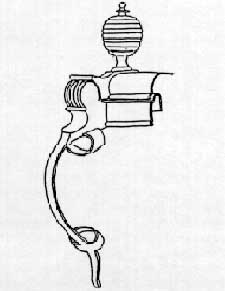 |
You will notice that the thumblift has migrated to a place of prominence over the lid. By 1700, virtually every stein being manufactured had a large, ball type thumblift over the lid. In the previous time frame, prior to 1680, stoneware dominated the market, but now faience was coming into popularity and would eventually push most stoneware out of the picture. Except for continuing production in the Westerwald, Duingen and Altenburg, most stoneware factories began to shut down, or at least discontinued beer stein production.
During the reign of William and Mary II of England (1689-1702) and that of Queen Anne that followed (1702-1714) the amount of tin reaching Germany probably remained fairly constant as the pewter on steins produced throughout that period would seem to indicate. However, in 1714 when Anne died, having outlived all seventeen of her children, the Act of Settlement of June 12, 1701 took effect, which declared that no Catholic may become king of England and when the Stuart family no longer had any Protestant heirs Great Britain must turn to the German house of Hanover. So, George the Elector of Hanover, the Grandson of James I, became George I of England, the first Hanoverian king (1714-1727). This marked the beginning of the golden age of German pewter.
|
|
|
During this period there seems to have been so much tin available that pewterers were hard pressed to find ways to use it. It was no longer sufficient to be a technically proficient pewtersmith, one also had to be an artist. See Figures 5, 6 and 7.
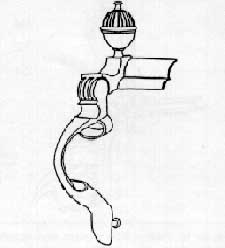 |
Figure 8 shows a handle repair replacing the lower portion of the handle with a pewter sleeve or boot soldered to the handle reinforcement strap and held to the body by punching a hole in the body of the stein through which a pewter plug extended from the sleeve to the inside of the stein. This plug is then expanded flush against the inside of the stein holding everything in place.
I called this age Early Biedermeier, but could just as well have called it Early Industrial Revolution or simply the Age of Revolution. In 1776, Britain’s American colonies revolted and produced the world’s first democratic republic. France soon followed with its own revolution in 1789, but the man responsible for the greatest revolution of his time was a Scot by the name of James Watt who was the inventor of the steam engine which made the Industrial Revolution and the modern world possible.
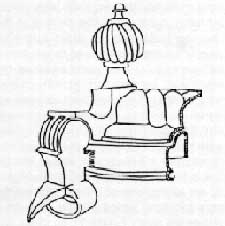 |
Just as there is little to determine the exact dating of pewter made between 1500 and 1680, there is also little to determine the exact dating of that made between 1680 and 1775 except perhaps by the quantity used and the artistic level achieved. However, from 1800 on and for the next 150 years, a number of changes take place which makes our determination of a stein’s age a simple process — comparatively speaking, that is.
After the Napoleonic Wars, between 1815 and 1840, while the amount of pewter being used on steins was being reduced everywhere else, the town of Schrezheim produced a last flash of pewter greatness. From mid-point in the eighteenth century Schrezheim produced some of the most remarkable pewter to ever grace a beer stein and nearly all of it went onto the faience steins produced at the local factory which was founded in 1752 by a wine merchant named Johann Baptist Bux. He operated it until his death in 1800 when his heirs took over and operated it until 1833. It was sold to Franz Heinrich Wintergeist whose family had done all the painting of the faience since the factory had originally opened. The factory was one of the last to close and shut it’s doors in 1872. However, the demand for faience had already begun to drop off about the time old Johann passed away and glass was fast becoming the material of choice. The quality of Schrezheim pewter was amazingly consistent over the years. I don’t know if it was applied at the Bux factory, or done outside at an independent pewterer, but it appears to have always been done by the same pewter shop. Whatever the case may be, the decision was made, probably because of the decline in the faience business, to start applying pewter to the products of other manufacturers. So, in the early years of the nineteenth century Schrezheim pewter was applied to glass and stoneware steins as well as whatever faience was still being produced. Once you have seen pewter produced in the Schrezheim factory you will always be able to identify it, it is that distinctive. Figures 10, 11 and 12 are all samples of Schrezheim pewter from this time period. Figure 10 is on a stoneware stein, Figure 11 on glass and Figure 12 is on a faience piece.
|
|
|
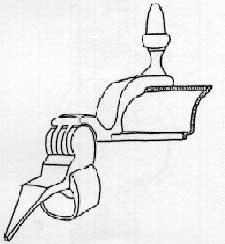 |
Even the stoneware factories in the Westerwald stopped producing steins around 1825 and except for sporadic production runs in the 1850s didn’t produce steins in any numbers until the early 1870s. Figure 13 is the pewter from what must be one of the last stoneware steins to come out of the Westerwald about 1825. The pewter is plain, very basic and has a small thumblift. It is a hint of what is to come.
The majority of steins we see from early in this time period are what we call the Biedermeier Wedding Stein, an enamelled 1 liter stein with a wide flared base. Their pewter is similar to Figure 13 except they have a larger, urn shaped thumblift and prior to about 1835, a footring to protect those wide flared bases, but the rising cost of tin took its toll and the footrings disappeared and when they went, the wide flaring bases had to go also. By 1840 we see the .5 liter glass stein, either etched or enamelled becoming predominant. The lids on these steins are now flat slabs cast to appear like they have a medallion inset in the middle. At this point the steins still have parallel walls, but soon many are tapered towards the top to further reduce the amount of pewter required. Finally, about 1850 the lid becomes a simple pewter ring holding either a glass or ceramic insert, and the thumblift is very thin and narrow as in Figure 14. Some still felt a need to reduce the amount of pewter being used even further, and around 1865 we find steins that are tall and narrow so that the lid diameter is reduced even more. These pieces also have very small diameter hinges and thin shanks as in Figure 15.
|
|
The Franco-Prussian War of 1870-71 seems to have been a turning point in many ways. Whatever the reason, the price of tin must have fallen dramatically, and the stoneware factories felt it was time to reintroduce the stoneware stein. By 1875 we find factories in both the Westerwald and Regensburg areas producing stoneware steins with large, fancy pewter lids and thumblifts. The thumblifts have also been moved back over the hinge as in Figure 16. This is also a time of transition from the closed hinge to the open hinge as in Figure 17. Both of the hinges, in Figures 16 and 17 can be classified as c. 1875. The first open hinges, as in Figure 17, are the heavy, open three ring hinges and these were used until about 1895 when the five ring, open hinge became the hinge of choice as in Figure 18.
|
|
|
In 1892, international trade agreements were signed requiring countries exporting goods to mark them with the name of the country of origin. Germany produced a plethora of cheap steins for export which had pewter fittings of very small dimensions that, I am sure, did not meet the fineness requirements for pewter being sold in Germany. The pewter is very soft and has a tendency to bend or break quite easily. See Figure 19. Although this is also an open, three ring hinge don’t confuse it with the one produced between 1875 and 1895. These puny fittings of low grade pewter were used on export steins from 1892 until at least World War I. Figure 20 is how you will quite often encounter this fitting.
|
|
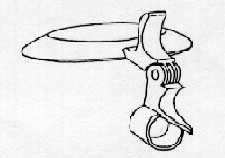 |
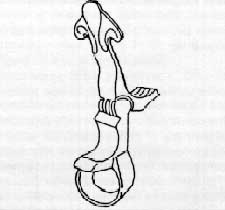 |
While we find all kinds of hinges and fittings being used today, the fittings in Figure 22 are some of the commonest post-war fittings and are c. 1950. Note that it uses a closed, five ring hinge. This does not mean it was made prior to 1875. Another feature to be aware of is the sweeping curve from the tang right up to the tip of the thumblift.This pewter exhibits casting and stamping marks, is overly shiny, and usually marked inside the lid with the letters D.B.G.M. Most modern pewter from about 1960 on has a velvety, sandblasted texture to the surface and the hinges are often rough appearing with what seem to be file marks.
While this article won’t make you an expert on dating your steins and their pewter, it may at least make it possible for you to pick up a stein in your local flea market that the dealer has marked and priced as an antique and know that it was made around 1950.
Bibliography
Gruhl, Jim and Kirsner, Gary. The Beer Stein Book, Glentiques, Ltd., Coral Springs, FL., 1990.
Hornsby, Peter R.G., Pewter of the Western World, 1600-1850, Schiffer Publishing, Ltd., Exon, Pennsylvania, 1983.
Reinhart, Kurt F., Germany: 2000 Years, vol. II, The Continuum Publishing Co., New York, 1961.
Webster’s Encyclopedic Unabridged Dictionary of the English Language, “Chronology of Major Dates in History,” Gramercy, Books, New York. 1989.
__________
*Reprinted by permission from Prosit, the Journal of Stein Collectors International, Vol 2, No. 7, September 1993